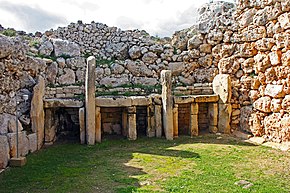| UNESCO World Heritage Site | |
|---|---|
 | |
| Location | Malta |
| Includes | |
| Criteria | Cultural: (iv) |
| Reference | 132ter |
| Inscription | 1980 (4th Session) |
| Extensions | 1992, 2015 |
| Area | 3.155 ha (339,600 sq ft) |
| Buffer zone | 167 ha (0.64 sq mi) |
The Megalithic Temples of Malta (Maltese: It-Tempji Megalitiċi ta' Malta) are several prehistoric temples, some of which are UNESCO World Heritage Sites,[1] built during three distinct periods approximately between 3600 BC and 2500 BC on the island country of Malta.[2] They had been claimed as the oldest free-standing structures on Earth until the discovery of Göbekli Tepe in Turkey.[3] Archaeologists believe that these megalithic complexes are the result of local innovations in a process of cultural evolution.[4][5] This led to the building of several temples of the Ġgantija phase (3600–3000 BC), culminating in the large Tarxien temple complex, which remained in use until 2500 BC. After this date, the temple-building culture disappeared.[6][7]
The Ġgantija temples were listed as a UNESCO World Heritage Site in 1980.[8] In 1992, the UNESCO Committee further extended the existing listing to include five other megalithic temple sites. These are Ħaġar Qim (in Qrendi), Mnajdra (in Qrendi), Ta' Ħaġrat Temples (in Mġarr), Skorba Temples (in Żebbiegħ) and Tarxien Temples (in Tarxien).[8] Nowadays, the sites are managed by Heritage Malta, while ownership of the surrounding lands varies from site to site.[9][10] Apart from these, there are other megalithic temples in Malta which are not included in the UNESCO World Heritage list.
- ^ "21 World Heritage Sites you have probably never heard of". Daily Telegraph. 4 March 2018.
- ^ "Megalithic Temples of Malta – UNESCO World Heritage Centre". Whc.unesco.org. Retrieved 2011-10-09.
- ^ "The Prehistoric Archaeology of the Temples of Malta". Bradshawfoundation.com. Retrieved 2009-07-22.
- ^ Blouet, The Story of Malta, p. 22
- ^ "Prehistoric Temples of Malta". Retrieved 2008-09-16.
- ^ Blouet, The Story of Malta, p. 28
- ^ "Malta: Ancient Home to Goddesses and Fertility Cults". Archived from the original on 2006-12-14. Retrieved 2008-09-16.
- ^ a b "Megalithic Temples of Malta". Retrieved 2008-09-16.
- ^ "Malta Temples and The OTS Foundation". Otsf.org. Retrieved 2009-07-22.
- ^ David Trump et al., Malta Before History (2004: Miranda Publishers)
